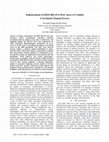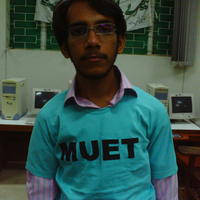Papers by jasvinder pal Singh

2011 IEEE Eighth International Conference on Mobile Ad-Hoc and Sensor Systems, 2011
ABSTRACT In populated indoor environments, the radio signal quality is heavily influenced by chan... more ABSTRACT In populated indoor environments, the radio signal quality is heavily influenced by channel impairments caused by movement of people, obstacles, or radio interferences. In such environments, high packet drop rates lead to frequent retransmissions and increased energy consumption of resource-restricted wireless nodes. To overcome this, we propose a novel Forward Error Correction (FEC) based adaptive error control strategy that employs a cascaded fuzzy inference system to combat communication unreliability. The strategy unifies various heterogeneous metrics such as signal-to-noise ratio, line-of-sight/non-line-of-sight detection and ACK/NACK to closely estimate the low-power links' quality and based on that, selects an appropriate FEC code to protect packet transmissions. Numerical evaluations are carried out using a realistic indoor fading channel model and IEEE 802.15.4 2.4 GHz modulation format. The performance results obtained from a comparative analysis with static and Adaptive FEC Code Control schemes (AFECCC) conclude that the proposed adaptive scheme guarantees better trade-off (packet error rate and energy-efficiency) for indoor WSN applications.

Annals of the Rheumatic Diseases, 2012
ABSTRACT Background Risks of hospitalized infections associated with newer biologic agents have n... more ABSTRACT Background Risks of hospitalized infections associated with newer biologic agents have not been well characterized in relation to risks with anti-TNF therapy, especially in rheumatoid arthritis (RA) patients with high comorbidity burdens. Objectives To compare the risk of hospitalized infections among RA patients switching from anti-TNF therapy to rituximab (RTX), abatacept (ABA) or another anti-TNF. Methods Using data from 2002-10 from the U.S. Veteran’s Health Administration, we identified a cohort of 38453 RA patients. Eligible patients started RTX, ABA, or anti-TNF therapy after prior exposure to another anti-TNF agent. To minimize confounding from channeling of cancer patients to certain biologics, patients with a history of cancer were excluded to form 2 cohorts: Exclusion for any type of prior cancer using all available data (3257 episodes, 2559 patients) or exclusion only for hematologic cancer in the prior 12 months (3848 episodes, 3018 patients). Baseline characteristics defined in 1 year prior to treatment initiation. Exposure was as-treated based upon days supply (injections) or usual dosing intervals (infusions), with 12 months assumed for RTX exposure. Current exposure was extended by 90 days for all biologics. The outcome was hospitalization with primary diagnosis code for bacterial infection. The hazard ratio (HR, 95% CI) for infection for RTX and ABA vs. anti-TNFs was calculated, adjusting for multiple potential confounders. Results 523 RTX, 366 ABA and 2959 anti-TNF switcher episodes were identified in RA patients without hematologic cancers; 15% of treatment episodes were further excluded with the more restrictive cancer exclusion to form a 2nd cohort. This cohort’s mean overall age was 60.8±10.7 years, 87% male, 25% diabetes, 15% COPD, 3% heart failure, and 66% used glucocorticoids. 2/3rd of the anti-TNF exposure was adalimumab. The most common types of hospitalized infections were pneumonia (36%), skin/soft tissue infections (26%), gastroenteritis (7%) and urinary tract infections (6%). In the less restrictive RA cohort, crude hospitalized infection rates/100person years were RTX: 15.9, ABA: 10.2 and anti-TNF: 12.7. In the less restrictive RA cohort, adjusted HRs for infection were comparable to or lower than for anti-TNF therapy: RTX: 0.85 (0.62-1.12) and ABA: 0.72 (0.50-1.10). In the more restrictive RA cohort, results were similar: adjusted HR for RTX: 0.76 (0.50-1.15) and ABA: 0.58 (0.36-0.93) compared to anti-TNF therapy. Multiple comorbidities and medications were associated with infections (diabetes HR=1.4, 95% CI 1.1-1.7; chronic lung disease HR=1.5, 1.1–1.9; prednisone >7.5mg/day HR=2.1, 1.6-2.7). Conclusions In older, predominantly male, US veterans with RA and high comorbidities, risks of hospitalized bacterial infections for patients treated with RTX or ABA were comparable to or lower than for patients switching to a different anti-TNF therapy (mostly ADA). Ongoing work is characterizing the comparative risks of opportunistic infections. Disclosure of Interest J. Curtis Consultant for: Roche/Genetech, UCB, Centocor CORRONA, Amgen, Pfizer, BMS, Crescendo, Abbott, S. Yang: None Declared, N. Patkar: None Declared, L. Chen: None Declared, J. Singh Grant/Research support from: Takeda, Savient, Consultant for: URL pharmaceuticals, Takeda, Ardea, Savient, Allergan, Novartis, G. Cannon: None Declared, T. Mikuls: None Declared, E. Delzell Grant/Research support from: Amgen, K. Saag Consultant for: Amgen; Lilly; Merck; Novartis; Savient; Ardea; Regeneron; URL, Abbott; DSMB – BioCryst; Roche; Lilly, M. Safford: None Declared, S. Duvall Grant/Research support from: Anolinx, LLC, Genentech, Roche, Amgen, Shire, K. Alexander Employee of: Genetech, P. Napalkov Employee of: Genetech, A. Kamauu Employee of: President- Anolinx LLC, J. Baddley Consultant for: Abbott, Merck
Journal of Chemical Research, 2015
ABSTRACT

2011 IEEE International Symposium on a World of Wireless, Mobile and Multimedia Networks, 2011
In indoor environment, the IEEE 802.15.4 low-rate, low-power packet transmissions experience stat... more In indoor environment, the IEEE 802.15.4 low-rate, low-power packet transmissions experience statistical correlation between channel errors due to interference and multipath fading. The 802.15.4 MAC layer implements an ARQ (Automatic Repeat-Request) mechanism for error recovery. In this work, we investigate the impact of correlated errors on the ARQ mechanism. The MAC layer back-off strategy employs a uniform random distribution to choose back-off values; which often reduces retransmission resolution time when packets confront collisions or transmission errors. We therefore propose the application of non-uniform (skewed) distribution which improves the system performance. Furthermore, an adaptive back off strategy, fastEI-slowED is developed for IEEE 802.15.4 MAC protocol to combat channel errors in time varying conditions. A detailed comparative analysis is presented employing accurate models of wireless channel and MAC protocol. Numerical results indicate that proposed scheme performs better, especially in worst channel conditions, when long duration error bursts are more frequent.

IEEE Global Telecommunications Conference, 2004. GLOBECOM '04., 2004
For a single user Gaussian channel, the minimum power required to meet a specified BER at the rec... more For a single user Gaussian channel, the minimum power required to meet a specified BER at the receiver is wellknown. For multiple transmitters sending independent data to a single receiver (which uses separate linear filters for decoding each transmitter's symbols), the problem of optimizing transmitter codewords to maximize capacity has been addressed in [8][9]. For the above problem, it has been found that the codeword set which maximizes capacity also minimizes TMSE (Total Mean Square Error) at the receiver. Now consider transmitters which are sending correlated information to a single receiver under a total power constraint. Such a scenario can typically arise in sensor networks and is usually addressed using distributed source coding [4]. In this paper, we derive optimal codeword configurations which minimize the TMSE at the receiver under a total power constraint. We also show that minimizing the TMSE is equivalent to maximizing the sum capacity.
GLOBECOM '03. IEEE Global Telecommunications Conference (IEEE Cat. No.03CH37489), 2003
We investigate practical methods of distributed interference avoidance where users iteratively ad... more We investigate practical methods of distributed interference avoidance where users iteratively adapt their codewords in response to global feedback from the receiver. In turn, the receiver adaptively tracks user codewords and offers a reasonable alternative to feeding back codewords. We introduce variants of standard interference avoidance procedures which produce more easily tracked incremental codewords and study the response of the system to abrupt changes in the interference background as might be encountered in a practical system. Furthermore, the methods we propose are strongly reminiscent of adaptive equalization for which a large body of knowledge and hardware expertise exist.
Organic Process Research & Development, 2003
... Res., Synop.1997, 264. [CrossRef]. (15) Kad, GL; Singh, V.; Kaur, KP; Singh, J. Tetrahedron L... more ... Res., Synop.1997, 264. [CrossRef]. (15) Kad, GL; Singh, V.; Kaur, KP; Singh, J. Tetrahedron Lett.1997, 1079. [CrossRef]. Citing Articles. View all 2 citing articles. ... Daniel F. Fischer and Richmond Sarpong. Journal of the American Chemical Society 2010 132 (17), pp 59265927. ...
ChemInform, 2003
... Quinolinium Chlorochromate as an Efficient Reagent for Oxidative Cleavage of Oximes via the U... more ... Quinolinium Chlorochromate as an Efficient Reagent for Oxidative Cleavage of Oximes via the Use of Microwave Irradiation and Pestle/Mortar. Jasvinder Singh,; Monica Bhandari,; JasamritKaur,; Goverdhan L. Kad. Article first published online: 16 MAY 2003. ...

2010 2nd International Conference on Computer Engineering and Technology, 2010
ABSTRACT The energy consumption of sensor nodes, network induced delay and packet dropouts due to... more ABSTRACT The energy consumption of sensor nodes, network induced delay and packet dropouts due to congestion are the major concerns in some real time sensor network applications where measurements are reported regularly or periodically to perform control and actuation under a certain time constraint. Here, we address these issues in our TDMA scheduling (Hybrid) approach designed for cluster based large scale Wireless Sensor and Actuator network (WSAN). The proposed hybrid scheme inherently employs simple Breadth-first and Depth-first node visiting techniques over the routes to decide time slots of the nodes with spatial reuse possibilities in deterministic time. The approach suits well for the networks when the entire schedule is recomputed periodically due to maintenance or change in routing to balance the nodes energy. The scheme is analyzed in terms of savings in energy consumption, number of time slots, % slots reuse, throughput and packet dropout due to buffer congestion. Simulation results confirm that the approach is more desirable for the resource limited WSAN networks designed for industrial applications.
2008 IEEE International Conference on Communications, 2008
In this paper, the feasibility and capacity benefits of deploying low-cost relay nodes with in-ba... more In this paper, the feasibility and capacity benefits of deploying low-cost relay nodes with in-band wireless backhaul capability in cellular networks are studied. Our proposed scheme is similar to a cell-splitting architecture where the base station density is increased, thus reducing the effective cell size. Cell-splitting in an interference-limited deployment provides capacity gains that are proportional to the number of
Journal of Molecular Liquids, 2014
ABSTRACT
Natural Product Research, 2009
A new and short synthesis of nematocidal natural products, thiocyanatin A and 1,8,16-trihydroxyhe... more A new and short synthesis of nematocidal natural products, thiocyanatin A and 1,8,16-trihydroxyhexadecane, from readily available starting compounds 1,7-heptanediol and 1,9-nonanediol in six steps is described.
Pediatric Rheumatology, 2014











Uploads
Papers by jasvinder pal Singh